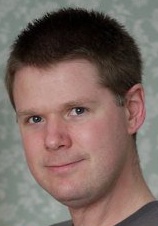Steve Sharples

|
Former Assistant Professor, Optics and Photonics Group
Email (@nottingham.ac.uk): stevedavid.sharples
I left the University of Nottingham on 30 September 2017. I still retain semi-formal ties with the research group, I am an "Associate" of the University; Matt Clark is my sponsor.
Previous research
I've worked in the field of laser ultrasonic research since 1997, and obtained my PhD, "All-Optical Scanning Acoustic Microscope" from the University of Nottingham in 2003. My research has centred around using novel laser ultrasonic techniques for materials characterisation and nondestructive evaluation (NDE). This has involved developing new techniques, new instrumentation, and new insights into the interaction of acoustic waves with materials. During the course of my PhD I improved the instrumentation to such a degree that for the first time we were able to take images – rather than single point measurements – of surface acoustic waves (SAWs) which were generated and detected using lasers. This improvement in the instrumentation led to an area of research on "Adaptive laser ultrasound with programmable optical field distributions" (2000-2003), which had profound implications for ultrasonic testing integrity. This was the study of the deleterious effects of anisotropy and microstructure on the propagation of ultrasound, and improving the methods and mechanisms to model, measure, analyse and predict this behaviour. Demonstrations of these effects led to revelations amongst many industrial (and some academic) collaborators, as it explained beautifully some of the phenomena (including unreliable data) that they had been seeing.
Success in this initial work led directly to a Core Project in the new Research Centre for NDE, formed in April 2003, titled "NDE of Difficult Materials" (2003-2007). My work here used the understanding of acoustic aberration to develop techniques in three key areas. (1) Using the information gained from the effects of acoustic aberration to infer statistical properties (mean grain size, degree of anisotropy) of the material under investigation. (2) Acoustic aberration correction, whereby the aberration is detected using a multi-channel acoustic detector which I had developed, and applying correction to the generation pattern. This cancels out the effects of the microstructure, giving greater confidence and clarity for the detection of defects. (3) Development of a new technique I termed "spatially resolved acoustic spectroscopy" (SRAS) which is capable of imaging microstructure, crucial for estimating likelihood of structure-sensitive failure mechanisms. Matt Clark and I are joint inventors on the patent for this technique.
From 2007-2008 I worked on a project entitled "Advanced ultrasonic techniques for highly scattering ordered and semi-ordered materials", which involved developing techniques for rationalising the amount of information necessary to determine key properties of these complex materials (such as degree of randomness, or porosity).
I was the principal researcher working on the RCNDE Core Project, "Laser ultrasonics for the detection of damage precursors" from 2008-2012. Conventional (linear) ultrasonics is very poor at detecting changes in the material structure of a component which have an influence on its working life, prior to the formation of measurable cracks and dislocations. New techniques are being developed in order to study the relationship between fatigue and the material elastic nonlinearity – a deviation from Hooke’s Law, which describes a linear relationship between stress and strain. Although these nonlinear ultrasonic techniques are potentially much more sensitive than linear methods, measurable changes are several orders of magnitude smaller than the equivalent changes in the linear response, so they are tricky to implement.
I was the principal investigator on a 2.5 year emda (East Midlands Development Agency) and Rolls-Royce funded Technology Demonstrator project, to develop the SRAS instrumentation for materials characterisation (1 April 2010 - 31 October 2012). This involved reducing the size of the SRAS instrument from one which takes up an entire optical bench, to one where all the optics could fit inside a shoebox, and to massively speed up the data acquisition, as well as providing much more quantitative data on material properties. Richard Smith was the researcher employed on this grant.
More recently I was the principal investigator on an RCNDE Core Project spanning nearly two years, entitled, “From lab to field with high frequency laser ultrasonics,” Roger Light was co-investigator. This work further developed a CMOS integrated optical sensor that I named the SKED (speckle knife edge detector), invented and developed with Roger Light. This device, combined with some fairly routine electronics and optics, has the ability to detect ultrasound on optically rough surfaces, by adapting to the speckle of the received light. A patent for this device has been filed.
Current research
Current research - up to the point I left - includes a 4 year RCNDE funded project I am leading titled “NDE for Additive Manufacture”, the co-investigators are Matt Clark, Adam Clare and Chris Tuck. I was previously a co-investigator (Nottingham lead) on an EPSRC sponsored project titled “High deposition rate additive manufacture of complex metal parts (HiDepAM),” in collaboration with Cranfield University, who are leading this research. Both of these projects are concerned with the application of non-contact NDE methods for improving additive manufacture processes - in the case of "NDE for AM" the focus is on the selective laser melting (SLM) method (also known as "powder bed"), where the other project is focused on verifying improvements to the material properties due to improvements in the wire and arc additive manufacturing (WAAM) process developed at Cranfield University.
Former activities and responsibilities
- Laser Safety Officer providing expertise, consultation and form-signing
- Laser ultrasonics expertise, and look after the Laser Ultrasonics Lab (Tower 303-307) infrastructure:
- O-SAM and ARRO-SAM instruments
- SRAS (Spatially Resolved Acoustic Spectroscopy) for materials characterisation
- Ultrafast Lab
- Nonlinear Ultrasonics lab
- Ultrasonic scanning tank in Tower 1007 (Main Optics Lab)
- Some practical RF electronics expertise (Minicircuits stuff)
- Look after the main optics Linux server ("armchair"), and the local Linux network, with Roger Light and Matt